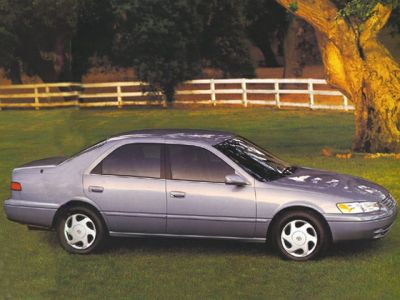 2003 Kia Optima I (facelift 2003) Dimensions, Size & Specs
2003 Kia Optima I (facelift 2003) Dimensions, Size & SpecsMeasurements of the 2003 Kia Optima I, engineered for optimal performance and comfort
| Dimensions | |
|---|---|
| Length: | 4719-4745 mm185.8-186.8 in15.5-15.6 ft |
| Width: | 1815 mm71.5 in6.0 ft |
| Height: | 1410-1420 mm55.5-55.9 in4.6-4.7 ft |
| Trunk Capacity: | 385 liter13.6 cu ft |
| Weight Specifications | |
| Curb Weight: | 1390-1497 kg3064-3300 lbs |
| Maximal permitted Weight: | 1985 kg4376 lbs |
| Tire Specifications | |
| Rims Sizes: |
|
| Tire Sizes: |
|
The 2003 Kia Optima I (facelift) represents an enhanced version of Kia's midsize sedan produced between 2003 and 2005. This generation of the Optima exhibits a length ranging from 4719 mm to 4745 mm (approximately 185.9 to 186.8 inches), with a consistent width of 1815 mm (71.5 inches) and a height varying between 1410 mm and 1420 mm (55.5 to 55.9 inches). The design upgrades during the facelift maintained its sleek sedan proportions while refining both aesthetics and aerodynamics.
Weighing between 1390 kg and 1497 kg (3,062 to 3,301 lbs) in curb weight, the Optima offers a balance between sturdy build and efficient performance, with a maximum permissible weight of 1985 kg (4,376 lbs). This ensures the vehicle can comfortably accommodate passengers and cargo without compromising safety or handling.
Storage practicality is supported by a luggage capacity of 385 liters (13.6 cubic feet), providing adequate space for everyday needs and light travel, typical of midsize sedans in its class. The Optima I facelift rides on either 14-inch or 15-inch rims, paired with tire sizes of 195/70 R14 and 205/60 R15, which contribute to a smooth ride and decent road grip.
Overall, the 2003 Kia Optima I facelift stands as a competitively sized sedan in the early 2000s market segment, offering a well-rounded package of size, weight, and functionality. Its dimensions and practical features make it suitable for those seeking comfort without sacrificing maneuverability in urban and highway driving conditions.
Discover the standout features that make the 2003 Kia Optima I a leader in its class
Have a question? Please check our knowledgebase first.
The Kia Optima I facelift produced between 2003 and 2005 has an overall length ranging from 4719 mm to 4745 mm (approximately 185.8 - 186.8 inches). Its width is consistently 1815 mm (about 71.5 inches), and the height varies slightly between 1410 mm and 1420 mm (around 55.5 - 55.9 inches). These dimensions place it solidly within the midsize sedan category, offering a spacious external footprint suitable for families and everyday use.
The curb weight of the Kia Optima I facelift from 2003 to 2005 varies between 1390 kg and 1497 kg (approximately 3,064 to 3,301 pounds). This range depends on specific trims, engine configurations, and optional equipment loaded onto the vehicle. The variation reflects differences in features such as transmission type, safety equipment, and possibly additional trim enhancements that slightly affect the overall mass of the car.
The Kia Optima I facelift model (2003-2005) has a maximum permissible weight of 1985 kg (approximately 4,375 pounds). This value represents the total weight allowance including the vehicle's curb weight plus maximum occupant and cargo load. It ensures safe driving limits are maintained, and is essential information for comparing payload capabilities when considering this midsize sedan for daily commuting or longer trips.
The luggage capacity of the Kia Optima I facelift from 2003 to 2005 stands at 385 liters (roughly 13.6 cubic feet). This trunk space is competitive in the midsize sedan class, providing ample room for groceries, luggage for a weekend trip, or other cargo. The well-proportioned trunk opening allows for easy loading and unloading, catering conveniently to family or daily use requirements.
The Kia Optima I facelift during model years 2003 to 2005 commonly comes with rim sizes of 14 or 15 inches. Correspondingly, the tire sizes are 195/70 R14 or 205/60 R15. These specifications balance ride comfort, handling, and fuel efficiency, typical for midsize sedans of this era. The tires and rims also contribute to the overall driving dynamics and aesthetics of the car.
Yes, the Kia Optima I facelift (2003-2005) generally fits comfortably into a standard residential garage. With a length between 4719 mm and 4745 mm (185.8 to 186.8 inches) and width of 1815 mm (71.5 inches), it is within the typical dimensions that standard garages accommodate, which usually have door widths of around 2400 mm (94.5 inches) and depths of about 5400 mm (212.6 inches). The modest height between 1410 mm and 1420 mm (55.5 to 55.9 inches) also ensures comfortable vertical clearance.
The Kia Optima I facelift introduced in 2003 slightly refined the design and dimensions of the original Optima I generation. While both versions fall into the midsize sedan category, the facelifted version typically features a marginal increase in length, stretching up to 4745 mm versus slightly shorter lengths in the initial generation. Width and height remain largely consistent, reflecting a focus on modernizing aesthetics and functionality rather than major dimensional changes. The facelift also brought subtle improvements in interior space utilization and cargo capacity.
In comparison to other midsize sedans from the early 2000s, the Kia Optima I facelift (2003-2005) offers competitive dimensions with a length of around 4720-4745 mm, width of 1815 mm, and height near 1410-1420 mm. Models like the Honda Accord, Toyota Camry, and Hyundai Sonata from the same period have similar length and width, although some variations exist depending on specific trims. The Optima's luggage capacity of 385 liters is respectable but marginally less than some rivals that often offer over 400 liters in trunk space. Overall, the Optima blends a well-sized footprint with a solid weight range, balancing fuel economy and performance effectively among contemporaries.
The 2003-2005 Kia Optima I facelift brought several updates over its predecessor, enhancing both aesthetics and functionality. Externally, the facelift included refreshed front and rear styling, updated headlights, taillights, and grilles that gave the car a more modern and appealing look. Inside, improvements focused on better-quality materials, ergonomic adjustments, and added creature comforts, such as improved air conditioning and infotainment options. Mechanically, the facelift saw refinements in suspension tuning for enhanced ride comfort and handling, along with updates to powertrain options to meet emissions and performance standards. Overall, the facelifted Optima positioned itself as a competitive midsize sedan choice in its market segment.
While detailed interior dimensions such as legroom and headroom for the Kia Optima I facelift (2003-2005) are not specified here, midsize sedans of this size typically provide comfortable seating for five passengers. The exterior width of 1815 mm (71.5 inches) allows for reasonably spacious front and rear seats, accommodating most adults comfortably. The height between 1410 mm and 1420 mm (approximately 55.5 to 55.9 inches) contributes to sufficient headroom. Kia focused on maximizing interior ergonomic space in the facelift, resulting in a practical and comfortable cabin suitable for family use and daily commuting.
Discover similar sized cars.

| Production: | 1989-2000 |
|---|---|
| Model Year: | 1989 |
| Length: | 4765 mm187.6 in |
| Width: | 1799 mm70.8 in |
| Height: | 1411-1418 mm55.6-55.8 in |

| Production: | 1991-1996 |
|---|---|
| Model Year: | 1990 |
| Length: | 4740 mm186.6 in |
| Width: | 1775 mm69.9 in |
| Height: | 1410-1420 mm55.5-55.9 in |

| Production: | 1992-1998 |
|---|---|
| Model Year: | 1992 |
| Length: | 4695 mm184.8 in |
| Width: | 1750 mm68.9 in |
| Height: | 1340 mm52.8 in |

| Production: | 1996-1999 |
|---|---|
| Model Year: | 1996 |
| Length: | 4765 mm187.6 in |
| Width: | 1785 mm70.3 in |
| Height: | 1410-1430 mm55.5-56.3 in |

| Production: | 1995-2000 |
|---|---|
| Model Year: | 1996 |
| Length: | 4740 mm186.6 in |
| Width: | 1803 mm71.0 in |
| Height: | 1374-1380 mm54.1-54.3 in |

| Production: | 1997-2005 |
|---|---|
| Model Year: | 1997 |
| Length: | 4790-4940 mm188.6-194.5 in |
| Width: | 1850 mm72.8 in |
| Height: | 1440 mm56.7 in |

| Production: | 1998-2003 |
|---|---|
| Model Year: | 1999 |
| Length: | 4822 mm189.8 in |
| Width: | 1832 mm72.1 in |
| Height: | 1434-1450 mm56.5-57.1 in |

| Production: | 1998-2004 |
|---|---|
| Model Year: | 1999 |
| Length: | 4740 mm186.6 in |
| Width: | 1780 mm70.1 in |
| Height: | 1390 mm54.7 in |
